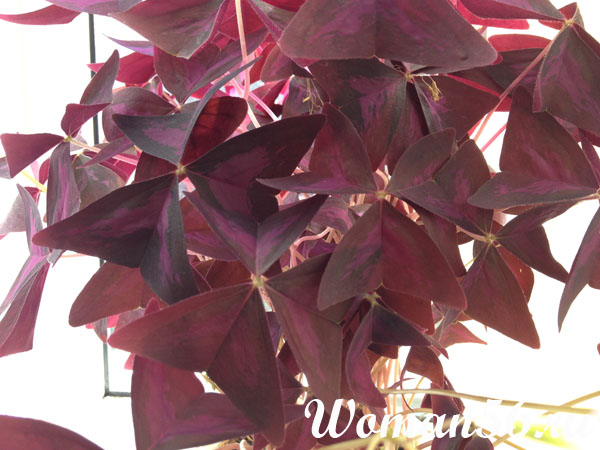Oxalis room - triangular oxalis flower
Oxide is room triangular. Description
Triangular oxalis or oxalis triangularis is a short (15-25cm) plant with a creeping rhizome. The leaves are dark purple, forming three- or four-leafed joints on long, thin stems. The flowers are small in umbrella-shaped inflorescences, bell-shaped pink or purple, sometimes just white.
It is very interesting to watch the sour cherry, when it folds leaves, and some species also flowers, at night or in cloudy weather.
Oxalis flower is a frost-resistant plant. Therefore, she is taken out into the street only in the summer, when the warm weather has already settled down and is returned to the apartment even before the first autumn frosts.
Oxalis can be grown outdoors, but only as an annual plant, but in this case it gives seeds.
Triangular oxalis is a herbaceous shrub with beet-colored leaves lightening towards the middle. A shamrock on a thin stem resembles a clover. The length of the stem can increase markedly with a lack of light. The plant rolls up its leaves at nightfall, and hibernates in winter and can completely shed its foliage.

Room triangular oxalis is a charming flower whose leaves look so much like a butterfly.
Room acid. Care and reproduction
Lighting
The lighting is preferably diffused, because in direct bright light, the leaves of the room sourwood fold and fall, it feels like the flower is withering. Therefore, avoid direct sunlight on the plant.
Temperature
The optimum temperature for moderate air humidity is 20 degrees. If the temperature is higher and the air is dry, then room oxalis will not bloom. If the temperature is below 14 degrees, then the plant will shed its leaves and enter a dormant phase until spring. In the resting phase, you need to lower the temperature to 12 degrees, moving it to a cool room.
The soil
The oxalis flower prefers light soil: a mixture of sand, deciduous and peat lands in a ratio of 1: 2: 1. When planting on open soil, you don't need to worry too much - the plant is not very whimsical, although there should still not be an abundance of clay in the soil.

Although oxalis is not whimsical enough, it is still better for it to develop in good lighting without direct sunlight. The flowering period is usually March to November.
Top dressing
Room acid is fed from May to August every 2-3 weeks. For feeding, the soil is carefully loosened beforehand, and complex mineral fertilizers are used in an amount 2 times less than indicated on the package itself.
Air humidity
Watering
In the summer, sour water needs abundant-moderate watering, but at the same time it is necessary to ensure that the water in the pot does not stagnate. In the autumn period, the abundance of watering gradually decreases, and in winter it is enough that the soil does not dry out. During the dormant period, the flower does not need watering, but when the first shoots appear, the plant is transplanted into fresh soil, returned to a warm room and watering is resumed.
Transfer
For transplanting room acid, the most suitable soil is prepared for it, and the bottom layer is supplied with a drainage bedding made of expanded clay. The plant is best replanted annually, preferably when it leaves the dormant phase.

Interesting! But, in Europe, they really believe that oxalis brings happiness if you give it on the last day of the year for the New Year. They call it that - "clover of happiness".
Reproduction
Under indoor conditions, oxalis does not produce seeds, therefore it reproduces vegetatively, that is, by dividing rhizomes during transplantation. Small tubers are formed around the taproot. Such tubers are transplanted into standard pots, 5-10 tubers for each, 1 cm of soil is closed on top of them. The development cycle of a plant from a tuber is 30-40 days, depending on the season. The oxalis flower develops quite quickly and in two years an adult plant will grow from the tuber. Also picky about care, grows quickly and blooms for a long time royal geranium, it is not for nothing that it is considered one of the most beloved and common indoor plants among flower growers.
If you decide to grow sour cherry from seeds, then it is worth considering several factors:
The plant only produces seeds if grown outdoors;
The seeds are very small and are therefore sown rather than planted;
The sown seeds do not need to be covered with earth;
The soil is moistened with a sprayer, spray irrigation will destroy the seed.
Oxalis flower. Resting phase withdrawal
From November to February, the plant can go into a dormant phase if there is a lack of heat and light. There is no need to be afraid, this phase is useful for the plant - there is nothing superfluous in nature. If the flower is not allowed to go into this phase, it will get tired of constant activity and will cease to bloom and multiply abundantly. The best option would be to give it a full winter: let it shed some of the leaves and rest.

Kislitsa is not particularly demanding on top dressing. In summer, the oxalis flower can be taken to the country house, where it will get stronger and gain new strength and colors, but in winter it is better to arrange the dormant period characteristic of this plant by placing the plant in a cool, dry place.
At the beginning of autumn, start to reduce the intensity of watering, gradually dim the artificial lighting according to the season and slowly reduce the temperature to 12-14 degrees. If the plant has dropped its leaves completely, then it no longer needs watering. Such a deep period of the dormant phase lasts a month and a half, then the plant begins to sprout. After the plant has begun to wake up, it is best to transplant it and start full care.
Oxalis flower. Diseases and pests
With a lack of light, room oxalis can lose all its charm: the stems will stretch out in search of light, and the leaves themselves will become smaller, it will not bloom. If the plant is exposed to direct and intense sunlight, burns may appear on the leaves. It is also not uncommon for the roots to rot due to improper watering, in which case the oxalis can get sick with fusarium or gray rot. The plant tolerates a lack of water better than an excess of it.

The soil should not dry out, sour water needs moderate watering, and during rest it practically does not need watering and spraying.
Oxalis is susceptible to aphids, mealybugs, whiteflies, scale insects, and spider mites. Therefore, at the first signs of the appearance of pests, the plant is treated with insecticidal preparations. Although the plant is not very susceptible to pests and diseases, you still should not deprive it of attention.
Indoor triangular oxalis is not a particularly picky plant, it can adapt to most conditions, but in this case it will no longer delight you with its beauty and flowers. It will turn into a faded dwarf shrub with thin and sparse stems. Therefore, it is still worth looking after her. After all, it requires very little.
